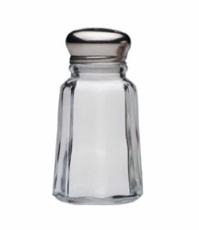 |
 |
 |
Other Health Topics:

-
Related Topics
-
Go Local
- Services and providers for Dietary Sodium in the U.S.
-
National Institutes of Health
- The primary NIH organization for research on Dietary Sodium is the NIH Office of Dietary Supplements
Languages
- Hmong (Hmoob)
- Spanish (español)
- Vietnamese (Tiếng Việt)
Table salt is made up of the elements sodium and chlorine - the technical name for salt is sodium chloride. Your body needs some sodium to work properly. It helps with the function of nerves and muscles. It also helps to keep the right balance of fluids in your body. Your kidneys control how much sodium is in your body. If you have too much and your kidneys can't get rid it, sodium builds up in your blood. This can lead to high blood pressure. High blood pressure can lead to other health problems.
Most people in the U.S. get more sodium in their diets than they need. A key to healthy eating is choosing foods low in salt and sodium. Doctors recommend you eat less than 2.4 grams per day. That equals about 1 teaspoon of table salt a day. Reading food labels can help you see how much sodium is in prepared foods.
National Heart, Lung, and Blood Institute
-
Reduce Salt and Sodium in Your Diet
 (National Heart, Lung, and Blood Institute)
(National Heart, Lung, and Blood Institute)
-
Sodium(American Heart Association)
Also available in Spanish
| Basics | Learn More | Multimedia & Cool Tools |
|---|---|---|
| Research | Reference Shelf | For You |
|
-
Overviews
- Sodium(Merck & Co., Inc.)
- Sodium: Are You Getting Too Much?(Mayo Foundation for Medical Education and Research)
-
Latest News
- Salt Contributes to Resistant High Blood Pressure(09/19/2008, HealthDay)
- Low-Birth-Weight Babies at Risk for Salt Sensitivity(08/11/2008, HealthDay)
- Too Much Salt Boosts Blood Pressure(08/08/2008, HealthDay)
-
Nutrition
- Sodium Content (in Milligrams) of Selected Foods per Common Measure(Dept. of Agriculture) - Large PDF file
-
Related Issues
- Low-Sodium Diet: Why Is Processed Food So Salty?(Mayo Foundation for Medical Education and Research)
- Water Softeners: How Much Sodium Do They Add?(Mayo Foundation for Medical Education and Research)
-
Videos
-
 Cut Down on Salt and Sodium
Cut Down on Salt and Sodium (Healthy Roads Media) - Requires Flash Player
(Healthy Roads Media) - Requires Flash Player
-
-
Clinical Trials
-
ClinicalTrials.gov: Sodium, Dietary
 (National Institutes of Health)
(National Institutes of Health)
-
ClinicalTrials.gov: Dietary Sodium
 (National Institutes of Health)
(National Institutes of Health)
-
ClinicalTrials.gov: Sodium, Dietary
-
Journal Articles
References and abstracts from MEDLINE/PubMed (National Library of Medicine)
- Article: Relations between dietary sodium and potassium intakes and mortality from...
- Article: Potential role of progestogens in the control of adipose tissue...
- Article: Elimination of iodine-deficiency disorders in Tibet.
- Dietary Sodium -- see more articles
- Medical Encyclopedia Return to top
-
Directories
- Nutrient Lists(Dept. of Agriculture) - Links to PDF
-
Organizations
- Center for Nutrition Policy and Promotion
- Food and Drug Administration
- Food and Nutrition Information Center
- Food and Nutrition Service
-
National Heart, Lung, and Blood Institute

| Home | Health Topics | Drugs & Supplements | Encyclopedia | Dictionary | News | Directories | Other Resources | |
| Disclaimers | Copyright | Privacy | Accessibility | Quality Guidelines U.S. National Library of Medicine, 8600 Rockville Pike, Bethesda, MD 20894 National Institutes of Health | Department of Health & Human Services |
Date last updated: 22 September 2008 Topic last reviewed: 14 June 2008 |






